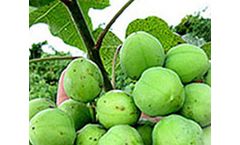Bioenergy Crop Articles & Analysis
16 news found
Their research helps to prioritize candidate genes that can be used for crop improvement and revealed new pathways and information about how plants fix carbon. ...
Heaton and others are studying how to strategically integrate second generation bioenergy crops, such as triticale, switchgrass and trees, with food and feed crops to provide marketable products as well as ecosystem services. Highly erodible, sloped fields could be planted, for example, with the deep-rooted bioenergy ...
Today Alterra and CLM, supported by Netherlands Enterprise Agency, jointly launched the tool BioESoil that allows farmers and advisors to assess the impacts of bioenergy production on soil quality. With a worldwide rising demand for biomass, uncontrolled production may cause a serious deterioration of soil quality. However, so far no methodology existed to assess the impact of biomass production ...
Large-scale cultivation of bioenergy crops on marginal land is unfeasible, according to a recent study. ...
Flavell will maintain his seat on the Ceres board of directors and now serve as an exclusive consultant to the company in the field of commercial bioenergy crops. Flavell joined Ceres in 1998 and has been instrumental in the establishment and development of Ceres' core technology platforms in plant genomics and biotechnology. ...
ByCeres
He has represented a wide range of clients, including agribusinesses, trade associations, and legislative and policy coalitions, on political and technical issues related to the environment, bioenergy, sustainability, food processing, and agricultural policy. His areas of expertise include water and air environmental policy; pesticide and fertilizer use policy; food production ...
Chuck West is a professor in the Crop, Soil & Environmental Sciences Department at the University of Arkansas. He teaches and conducts research on forages, environmental restoration, and bioenergy crops. He received his B.S. and M.S. in agronomy from the University of Minnesota, and Ph.D. from Iowa State University. ...
SG Biofuels, a bioenergy crop company using breeding and biotechnology to develop elite hybrid seeds of Jatropha, today announced it has signed customers for the deployment of 250,000 acres of Jatropha using its JMax™ hybrid seeds. Jatropha is a non-edible energy crop that produces large volumes of sustainable plant oil used for biodiesel, bio ...
SAN DIEGO - SG Biofuels, a bioenergy crop company developing and producing elite seeds of Jatropha, today announced it has established a strategic partnership with Bunge North America, the North American operating arm of Bunge Limited (NYSE: BG), to research and develop a model to process Jatropha seeds into a biofuel feedstock. ...
SAN DIEGO - SG Biofuels, a bioenergy crop company developing and producing elite seeds of Jatropha, today announced it has established a proprietary technology for large-scale Jatropha hybrid seed production. ...
Larry C. Purcell is a Professor and crop physiologist in the Crop, Soil, and Environmental Sciences Department at the University of Arkansas. ...
Agricultural economists Laura James and Scott Swinton teamed with agronomist Kurt Thelen to conduct a comparative breakeven budgeting analysis at Michigan State University and the Great Lakes Bioenergy Research Center. Their profitability analysis of cellulosic energy crops compared with corn appears in the March–April 2010 issue of Agronomy Journal. ...
A Dutch study has assessed the water requirements of 13 bioenergy crops across the world. The findings could help select the best crops and locations to produce bioenergy. ...
A recent study demonstrates that potential bioenergy crops in Hawaii are 2 to 4 times more likely to be invasive than other plants. ...
Other issues include the cost of conversion and the effects of climate and social policies. For bioenergy crops, the estimated yields and technology for producing bioenergy are also significant factors. ...
Improved management of crops and perennials could go a long way toward alleviating the problem of hypoxia, which claims thousands of fish, shrimp and shellfish in the Gulf of Mexico each spring. ...









